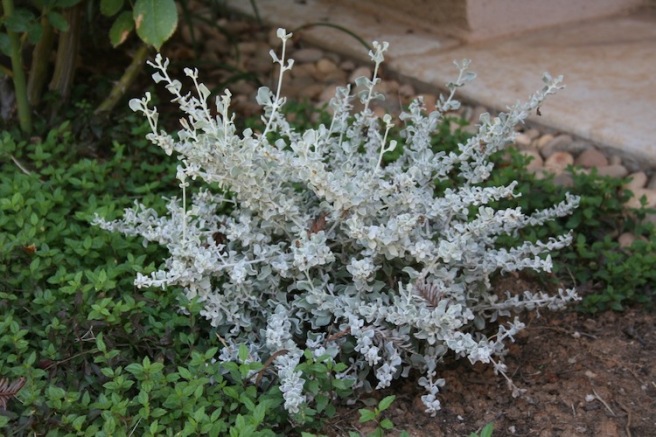It is a unique experience to see the inspirational garden of a noted San Jose garden designer and a very personal garden he crafted for a one of his clients in a single afternoon. The Garden Conservancy has a reputation for delivering fabulous garden touring experiences at its Open Days across the nation.
The Holden garden is only a few streets over from designer Cevan Forristt’s outdoor sanctuary. Both gardens lay in the flood zone for nearby Coyote Creek and found themselves under 6 feet of water in February 2017 when the creek ravaged its banks. It was amazing to see how beautifully they have recovered–I would have not known the depth of the damage to the Holden garden without seeing a photograph taken by the homeowners from their 2nd story.
Hints to the global nature of the garden appear on the front of the neat stucco bungalow in the form of Indonesian style shutters.

The front garden is no bigger than a minute but features design details in keeping with the global theme.


A Moorish tile front walk and massive pots lead to these stylized gates. The potted bamboo provides some leafy relief from the surrounding hard surfaces. It is possible that in a former life the steeply sloped walk into this below street grade garden was a driveway–possible a garage occupied space behind the bungalow?


There are so many details to take in I really don’t know where to look first. My initial impression is that this garden is a fabulous entertaining space–many seating and eating areas with enough green to blur the edges.
The property line fences and just about every surface has been dressed with texture advancing the global theme–remember this is the designer who made a century old Victorian into a Far Eastern sanctuary.

I love this trough plumbed with running water. No surface is without an artistic element.

I am immediately drawn to this massive shade structure which provides shelter for a custom poured concrete table which I think seats 12 or 16 on antique throne like chairs.

From a slightly different angle you can see the corrugated metal storage area and massive poured columns supporting the shade structure. The colored concrete columns were poured into tubes formed from sheets of corrugated metal.
Each column is capped with a unique pottery shard element. Designer Cevan Forristt purchased an entire warehouse of broken pottery from a company whose stock was destroyed in the 1989 Loma Prieta earthquake and has had those shards stored in numerous barrels for years, dipping into the booty to fashion one of a kind decorative elements for himself and his clients. Remember the blue pottery mosaic pots I shared with you in the post on Cevan’s garden? It is all I can do not to start collecting garage sale pottery…here are a few of the column cap designs. The substantial edge of the table also features a wide multicolored shard mosaic band.



This garden is accessible and inviting. Nothing is out of bounds and the space is appealing to both adults and impervious to children.


The natural materials of the green cushioned seating areas is a unifying factor. Throughout the garden there are a variety of materials used and repeated–corrugated metal, distressed/rustic wood, poured concrete, rusted iron and bamboo.

A six sided koi pond is the center point of the garden. As with all the poured concrete elements, the pond was made by the designer. A trough like spout provides a waterfall effect. The homeowners shared that the koi did not swim their way to safety from the flood waters and had to be replaced.



Above and below you see a few of the ceramic flora pieces created by Berkeley sculptor Marcia Donohue.


These organic pieces rise from the greens of the plant material as totems to the plant gods. I understand that Marcia Donahue’s Berkeley garden is a fabulous experience–chock full of plants and sculpture!

The planters and custom surround for the grill were fabricated with forms that are utilized to pour column for freeway overpasses.

This gorgeous piece serves as an outdoor buffett for storage of dishes and serve ware used for outdoor dining. Notice the corrugated metal ‘hat’ fashioned to allow the rain to run off.

Details evoking global travel abound.

Looking back toward the almost invisible home.

The second story overhang (Eastern US folks-think ‘walk-out basement’) creates a shady sitting and dining spot.

Looking out into the garden from that shady spot.

Same spot from the garden side. More poured concrete columns support a concrete table top at bar height.

Every detail remains in character.

I am so happy I got to see this masterful interplay of materials and plants. Evocative of global travel tucked within busy San Jose, this garden transports every visitor to far flung and mysterious places.




































































